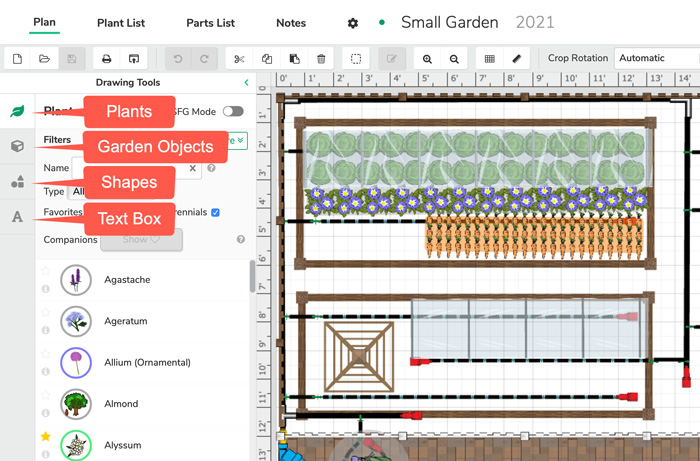Garden Planner Quick-Start Video
The Garden Planner makes it simple to create a productive vegetable garden plan. Let us show you how in this video:
Using the Garden Planner
The Garden Planner has been designed to solve many of the headaches of growing a successful garden by helping you to produce the perfect plan of what you'll grow where and when.
The first step is to add all of the key items that you have or plan to include in your garden. The Garden Planner has lots of ready-designed garden objects such as ponds, paths, fences and compost bins, which can be dropped straight into your plan.
Many of them, such as raised beds, glasshouses and sheds can be adjusted to fit your space. For odd-shaped gardens you can mark boundaries with lines or fences, which can be curved if necessary.

Then it's time to add plants. The Garden Planner has a database of almost 250 vegetables, herbs, fruits and nuts, and adding them to your garden plan is easy – just click on the plant to pick it up, click on your plan where you want to place it, and then hold down your mouse button and drag to draw a whole row or block.
As you add vegetables the space they require is clearly shown by the colored area around each plant, and the tooltip displays how many plants will fit into the area.
Detailed growing information is available from the information button, helping you to choose the perfect location for a favorite crop, or to check what type of soil is required.
You can also use the Filter button to narrow down the selection to show only crops that suit your requirements.
You can plan traditional rows or blocks, or if you're using the intensive Square Foot Gardening method, the Garden Planner has a dedicated SFG mode.
When adding plants in SFG mode, the Garden Planner automatically calculates how many of each plant can be grown in each square foot of space, and will indicate this in the top left corner of the square foot block. Switch back out of SFG mode if you want to return to adding rows of plants.
If using rows or blocks, the size and the number of plants will be displayed as a tooltip over the row or block.
More Useful Garden Planner Features
The Garden Planner has many other powerful features that make it easy to get more from your garden.
- Personalized sowing, planting and harvesting times
The Garden Planner adapts to your location by looking up the average frost dates for your area in our database of over 5000 weather stations. The Garden Planner uses this climate data to produce a personalized Plant List, showing how many of each plant you require and when to sow, plant and harvest them in your location. It's really easy to print this out to take it with you to your garden, or when out buying your supplies – alternatively, use the Publish Plan to Web feature to view it on any mobile device. Twice a month the Garden Planner sends email reminders of what can be sown or planted now from your garden plans to help you keep on track and not miss key planting dates.
- Succession planting
You can organize which crops will follow on from others using the succession planting feature, setting in-ground dates for your plants and viewing them month by month to show where gaps will appear.
Crop rotation. Each plant has a ‘crop family color', so you can easily identify it. Once you have entered more than one year's plan, the Garden Planner warns you about where you should avoid placing each vegetable based on what was in that area in previous years, helping to reduce the likelihood of soil-borne pests and diseases surviving from one year to the next.
- Irrigation
Designing irrigation for your garden is simple. You can use the Filter drop-down box to select Irrigation, and then use the various components to create your system. The Parts List will create an easy to use shopping list of the items you will need, based on your design. Other garden objects from your plan will also be listed here.
- Season extenders
Glasshouses, cold frames and row covers can all be used to extend the season, helping you to get a head start on raising those precious seedlings in the spring or keeping established plants going into the winter. The Garden Planner automatically updates the sow, plant and harvest times for your vegetables when you add these protective structures to your plan. They are displayed separately on the plant list, so you can easily keep track of the various stages of your plants' growth.
Planning your garden will ensure you've got all the information you need to start your plants at the best time and give them the best chance of survival through the growing season. With good planning, some hard work, and a little help from Mother Nature, you can look forward to harvesting a bumper crop.
Start the Garden Planner
Subscribe Here